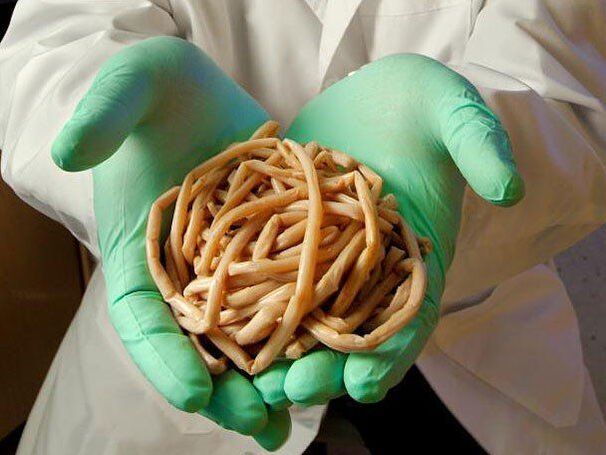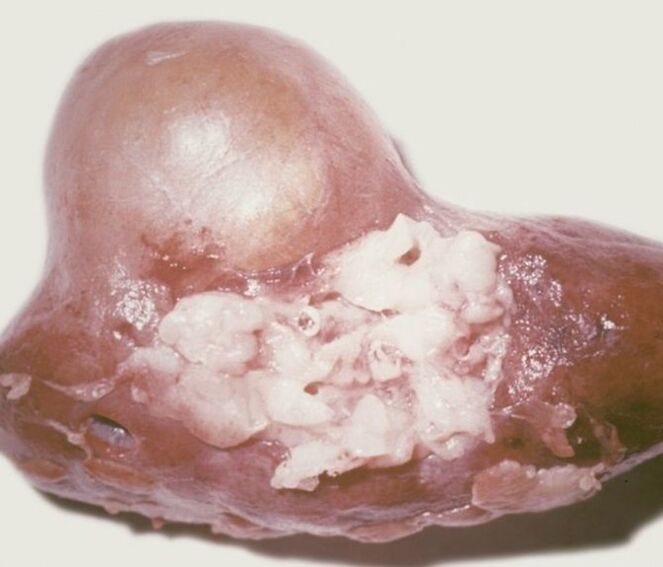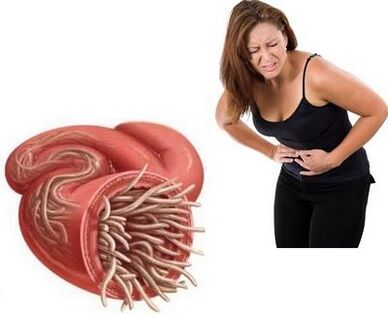Parasites - This is the name of one of the most common groups of infectious diseases.Today, about 300 parasites are known, which is a danger to people, including fatal.On the territory of the European continent, these are just a few dozen parasites (medical name - Helminthias, Helmintha Invasion).
Most of the parasites relevant to humans are common in countries with tropical and subtropical climate, as well as a low level of socio-economic development and sanitary culture.
What are dangerous parasites

Parasites in the human body can affect almost any system of the organ.The degree of damage depends on the type of helmint, the duration of the disease, the initial state of health.The sooner the diagnosis of specific helminism invasion is established, the higher the chances of a quick resolution of the parasites.Therefore, it is important to diagnose the state of invasion of parasites and perform all phases of treatment.
Almost every variant of Helmintis, especially long, causes significant damage to the human body.Hlybon invasion is the reason for delay in psycho-motor development in children of any age, significantly reduces performance and life reserves in an adult.
Regardless of the age of a person, the Helmin Invasion contributes to allergicization, reduces the ability of the immune system to resistance to infectious and other diseases, in addition, the efficiency of the continuous prophet prophylaxis is significantly reduced.
The cleaning of the body parasites in rare cases occurs spontaneously, in most cases, a certain treatment is required for a particular scheme.
What are the parasites

Parasites (they are also worms or worms) are an extensive group of multi-school complex regulated organisms that can long exist in the active condition in different conditions.An important characteristic is the ability to exist within the second living organism (person or animal), called "invasion".
Currently, different types of parasites in the human body are known.The most common classification of the parasites depending on their external structure and characteristics of the life cycle.
Given the biological characteristics, all parasites are divided into 3 large classes:
- Roundworms (They are also nematodes), for example, trichinel, anchylogom, pin, ascaris;
- Ribbons (They are also peppods), for example, alveococcus, echinococcus, ribbon wide, bull-clinical tapice, pork and dwarf;
- SuperSi (They are also tremons), for example, Opisturch, Fasiol, Clonorch.
In addition, as many other diseases, parasitic diseases differ:
- serious;
- Leading syndrome, ie which system of organs is largely damaged;
- the presence and nature of complications;
- Possible outcome of the disease.
Parasite characteristics
Development phase
Parasitic diseases characterize numerous differences associated with parasite characteristics and their life cycle.
The number of adult parasites in the human body does not increase, provided there is no new infection.The majority of the parasite requires a change of habitat (animal body, soil, etc.).
For any parasite, development phases are typical.Through the life cycle Helminth transmits a number of consistently changing stages of development.As a rule, the egg parasites turns into a person still into an adult.Inverted development does not appear, the egg cannot go to the adult stage immediately.
The parasite penetrates the human body in one stage of your life cycle and exits outside in another.With this moment it is not that not-treatment of practical people of human parasitic diseases are connected.That is, it is impossible to become infected with most parasitic diseases in direct contact with the infected person.
Possible ways of penetrating into the human body
With many types of parasites, a person can meet anywhere - are not visible to the naked eye.The following options are most likely:
- oral path, ie, with non-compliance with personal hygiene, using dirty or thermally untreated products;
- The percutaneous trail, ie larvae or adult parasites penetrate into human body damage to the skin, when contacting water or soil, while participating in blood insects.
Most parasites that affect the human body only live in the adult phase, mainly in the digestive tract.These are thus-are-charged intestinal parasites (Helminths).They in turn divided into 2 groups according to some features.
The intestinal parasites of the first groups enter into a human body in the form of an egg.They pretend to an adult in the digestive tract.The movements of such parasites (pinworms, wide tape, pork and tapaworm) are limited only to different departments of the digestive tract.
Representatives of the second group (their larvae or eggs) are significantly longer and more complex migrations towards different tissues and human body bodies.Only after that, an adult parasite adult is formed.It is clear that the symptoms of such parasitic diseases are much more diverse, because the migration process is associated with significant changes in the body.
Parasites, which are in the adult or larva phase, are located outside the digestive tract is called the tissue.If in the human body, the parasite exists only in the Larvina phase, then the person for him is an ecological dead end, which potential cannot leave.
Parasite life cycle features
To know how to get rid of the body parasites, it is necessary to be represented in general conditions for their life cycle.This knowledge also helps prevent parasites to enter the human body.
In accordance with the characteristics of the life cycle, all parasites are divided into:
- Geo parasites;
- Infectious helminthosis;
- Was helminthiasis.
In order to implement the life cycle of geographical parasites (Vlasov, Ne -core), the eggs need to have a certain period of time in the soil.In the future, with direct contact with dirty ground, the use of insufficient distorted vegetables, through dirty hands, penetrates parasites into the human body.
In contactable parasites (Pinworms, Patuljac Tabbells), all phases of development are happening only in the human body, without changing the environment.Only these types of parasitic diseases transmit directly from person to person.It is also possible, especially in childhood, cases of re-auto generation, ie in the case of non-compliance with hygiene rules and skills.
The most complex life cycle in the so-calm biogelmintosis.Prerequisite for the implementation of their life cycle The presence of the intermediate host.A person may either be an intermediary or final master.For example, with echinococcosis, the person is the middle host, and dogs and cats are final.In case of tuškerhosis, on the contrary, cattle representatives are middle hosts, and the person is final.
Symptoms of parasites
Clinical signs of parasites, on the one hand, are determined by the prevailing damage to a particular body, on the other hand, have general characteristics that allow us to distinguish the acute and chronic phase of the parasitic disease.
The acute phase of the parasitic disease corresponds to the phase of the migration of Helmintha development.They are manifested by such clinical signs as an allergic and general toxic reactions (ascariasis, Šistosomoza, fasciolees, trichinologists).
The immune component has a significant weight in the development of the acute phase of parasitosis, makes up a certain stereotype of clinical images and some similarities with other immune reactions of nonfective nature - medicine, allergic dermatitis and others.
The hidden period with most parasitosis is a few weeks, reduces 7-10 days with a massive version of the infection and extends the bad intensity.
The main symptoms of parasitic diseases are as follows:
- Increasing body temperature - from sub-catering to very high;
- muscle pain and joints, various durations and intensity;
- Formation of rashes on the entire surface of the skin, different size and intensity, with the overthrow of the skin;
- Significant edem of leather and subcutaneous tissue, less often - mucosa;Lowest for trichinosis that gave a disease with a characteristic popular name "Puffy";
- Development of pulmonary syndrome, namely, night cough, astmitoid attitudes, formation of pneumonia with the migration focus of damage;
- Development of abdominal syndrome, which characterizes moderate abdominal pain, liquid chair without impurities mucus and blood;
- In severe cases, the damage to the central nervous system and heart is respected;
- The distinctive characteristic of Helminthiasis is the change in peripheral blood: pronounce leukocytosis and significant eosinophilia (up to 30-40%).
In treatment in the acute phase phase of the parasite drugs in the human body, the most efficient.
In the phase of the chronic phase of parasitic diseases, the harmful effect determines the type of adult parasites.The negative effect on the human body is connected:
- larger toxic and less allergic effects;
- Mechanical damage to tissues in the parasisitation zone (for example, liver echinococcosis);
- absorption of nutrients, violation of metabolic processes, the development of anemia and cachexia;
- Heavy anemia;
- Increased irritability and exciting person;
- It is possible to join secondary infection and dissisosis, the weight of the flow of other infectious and inefficient diseases, as well as pregnancy.
The duration of the existence of individual parasites is different - from a few days and weeks (cutters) to many years.After a parasitic disease, re -infection is possible, because immunity is not formed.Therefore, simultaneous cleaning of the body from the parasites does not protect against the repeated episode of the disease.
Parasite treatment

Classic therapy with parasitosis drugs in the present has achieved significant success.Introduction to the clinical practice of joints and imidazole compounds enabled the successful treatment of many types of herminti.
These drugs have a wide range of exposure, small toxide with short during treatment, for adults and children is suitable for use.The appropriate amount of remedies of drugs should be respected.
How to clean the body of a particular parasite, which choice regime chooses and which drug decides the doctor.It is not recommended to prevent Helminti on the personal initiative, because drug addiction is developed, ie reduction in their performance.
Parasite cleaning
In addition to parasitosis, treatment of folk drugs is not less popular than traditional medicine.Fans of natural tools for parasitic diseases focus on the safety and universality of such therapy.There are a lot of recipe traditional medicine, which allows you to deal with the parasites in the human body quite effectively.The following parasite removal options in the human body are the most famous:
- Coriander and pumpkin seeds as a prophylactic and therapeutic agent for parasites;
- Alcohol tincture on chanting in combination with white mushrooms;
- Decociation of Borov Konus;
- The tincture of green walnuts.
All folk drugs for parasites should be in line with the recipe and clean hands.Before choosing a specific recipe, it is important to ensure that a person has no allergy to ingredients that are part of the drug.
How to protect yourself from parasites

Both are easy and difficult at the same time.A few simple rules will help reduce the risk of infection by any parasite:
- thorough hand washing;
- Real habit of using an individual set of dishes;
- Thoroughly process any meat and fish, condemn and salty fish and meat people are used with caution;
- treat vegetables and fruit with boiling water (after washing in liquid water);
- Always wash your hands with soap after communicating with animals (even domestic).
Parasitic infection at any time is an unpleasant problem, but it completely eliminates early treatment.






































